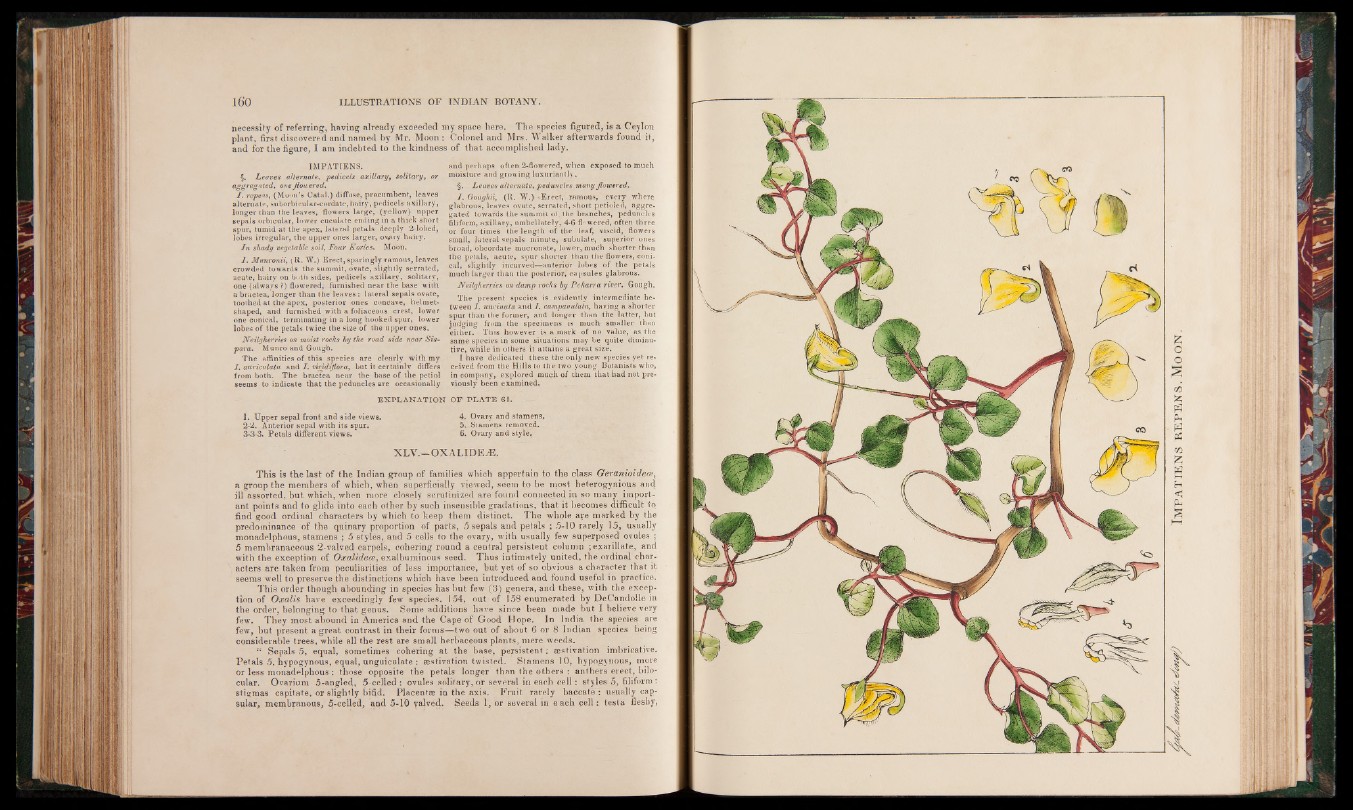
necessity of referring, having already exceeded my space here. The species figured, is a Ceylon
plant, first discovered and named by Mr. Moon : Colonel and Mrs. Walker afterwards found it,
and for the figure, I am indebted to the kindness of that accomplished lady.
IMPATIENS.
§. Leaves alternate, pedicels, axillary, solitary, or
aggregated, one flowered.
I . repens, (Moon’s Catal.) diffuse, procumbent, leaves
alternate, suborbieular-cordate,hairy, pedicels axillary,
longer than the leaves, flowers large, (yellow) upper
sepals orbicular, lower cuculate ending in a thick short
spur, tumid at the apex, lateral petals deeply 2 -lobed,
lobes irregular, the upper ones larger, ovirv hairy.
I n shady vegetable soil, Four Kories. Moon.
7. Munronii, (R. W.) Erect, sparingly ramous, leaves
crowded towards the summit, ovate, slightly serrated,
acute, hairy on both sides, pedicels axillary, solitary,
one (always ?) flowered,' furnished near the base with
a bractea, longer than thedeaves: lateral sepals ovate,
toothed at the apex, posterior ones concave, helmetshaped,
and furnished with a foliaceous crest, lower
one conical, terminating in a long hooked spur, lower
lobes of the petals twice the size of the upper ones.
Neilgherries on moist rocks by the road side near Sis-
para. Munro and Gough.
The affinities of this species are clearly with my
I . auriculata and I . viridiflora, but it certainly differs
from both. The bractea near the base of the petiol
seems to indicate that the peduncles are occasionally
EXPLANATION
1. Upper sepal front and side views.
2- 2. Anterior sepal with its spur.
3- 3-3. Petals different views.
and perhaps often 2-flowered, when exposed to much
moisture and growing luxuriantly.
§. _ Leaves alternate, peduncles many flowered.
I . Goughii, (R. W.) «-Erect, ramous, every where
glabrous, leaves ovate, serrated, short petioled, aggregated
towards the summit of.-the branches, peduncles
filiform, axillary, umbellately, 4-6 flowered, often three
or four times the length of the leaf, viscid, flowers
small, lateral sepals minute, subulate, superior ones
broad, obcordate mucronate, lower, much shorter than
the petals, acute, spur shorter than the flowers, conical,
slightly incurved-—anterior lobes of the petals
much larger than the posterior, capsules glabrous.
Neilgherries on damp rocks by Pekarra river. Gough.
The present species is evidently intermediate between
7. uncinata and 7. campanulata, having a shorter
spur than the former, and longer than the latter, but
judging from the specimens is much smaller than
either. This however is a mark of no value, as the
same species in some situations may be quite diminutive,
while in others it attains a great size.
I have dedicated these the only new species yet received
from the Hills to the two young Botanists who,
in company, explored much of them that had not previously
been examined.
OF PLATE 61.
4. Qvarv-and stamens,
5_Stamens removed.
6. Ovary and style.
XLV.—OXALIDEiE,
This is the last of the Indian group of families which appertain to the class Geranioidea?,
a group the members of which, when superficially viewed, seem to be most heterogynious and
ill assorted, but which, when more closely scrutinized are found connected in so many important
points and to glide into each other by such insensible gradations, that it becomes difficult to
find good ordinal characters by which to keep them distinct. The whole are marked by the
predominance of the quinary proportion of parts, 5 sepals and petals ; 5-10 rarely 15, usually
monadelphous, stamens ; 5 styles, and 5 cells to the ovary, with usually few superposed ovules ;
5 membranaceous 2 -valved carpels, cohering round a central persistent column ;exarillate, and
with the exception of Oxalidece, exalbuminous seed. Thus intimately united, the ordinal characters
are taken from peculiarities of less importance, but yet of so obvious a character that it
seems well to preserve the distinctions which have been introduced and found useful in practice.
This order though abounding in species has hut few (3) genera, and these, with the exception
of Oxalis have exceedingly few species, 154, out of 158 enumerated by DeCandolle in
the order, belonging to that genus. Some additions have since been made but I believe very
few. They most abound in America and the Cape of Good Hope. In India the species, are
few, but present a great contrast in their forms—two out of about 6 or 8 Indian species being
considerable trees, while all the rest are small herbaceous plants, mere weeds.
“ Sepals 5, equal, sometimes cohering at the base, persistent; aestivation imbricative.
Petals 5, hypogynous, equal, unguiculate : aestivation twisted. Stamens 10, hypogynous, more
or less monadelphous : those opposite the petals longer than the others : anthers erect, bilocular.
Ovarium 5-angled, 5-celled : ovules solitary, or several in each cell: styles 5, filiform :
stigmas capitate, or slightly bifid. Placentae in the axis. Fruit rarely baccate : usually capsular,
menibranous, 5-celled, and 5-10 yalved. Seeds 1, or several in each cell: testa fleshy,